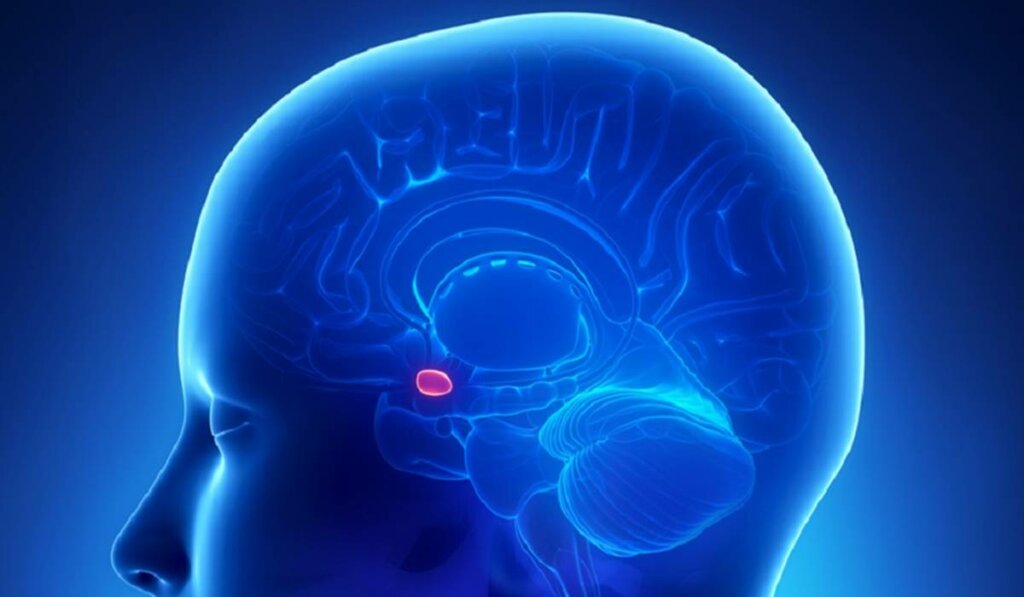The Functions of Growth Hormone (GH)


Reviewed and approved by the doctor Leonardo Biolatto
Growth hormone (GH) is secreted from somatotroph cells in the anterior pituitary gland. Thanks to this substance, both growth and development are favored. Furthermore, it fulfills certain important metabolic tasks.
In fact, since the functions of this hormone were initially discovered in the 1960s, it’s become one of the most interesting areas of research in the field of endocrinology. It’s also one of the most profitable.
For example, the administration of growth hormone in its synthetic version (somatropin) produced with recombinant DNA technology can treat multiple growth disorders and syndromes. Moreover, it’s also often used illegally for non-medical purposes. For instance, anti-aging treatments, muscle enhancement, physical resistance, and loss of body fat.
Undoubtedly, GH is an essential element in our biology. Its proper functioning depends on one of the most fascinating brain regions of the brain: the pituitary gland. This is a small structure that tends to decalcify early.

Growth hormone: Functions, alterations, and some curious facts
Growth hormone is a protein substance that stimulates infant growth. It also ensures the good health of tissues and organs. But, it’s not only limited to promoting development. In fact, it’s present in multiple processes in tasks that generally intervene in the good condition of the bones, muscles, etc. It’s also known as the anti-aging hormone.
The discovery of this hormone dates back to 1912. Dr. Harvey Cushing first identified it and highlighted its relevance to skeletal growth. At this time, its relationship was noted in relation to childhood growth disorders. Experts recognized how the deficit in its secretion or its hyper secretion led to diseases and disorders such as acromegaly. This is a disorder that causes gigantism.
Its functions
Growth hormone is a polypeptide made up of 191 amino acids. It’s produced in the pituitary gland and then released into the bloodstream. It’s a dynamic substance with multiple functions. Its mechanism of action depends on several factors.
When we reach middle age, the release of GH is reduced. Our physical condition and state of health also have an impact on its correct release. Its main functions are as follows:
- Stimulates the postnatal growth of the child.
- Mineralizes the bones and retains their concentration of calcium.
- Increases and promotes muscle mass.
- Promotes lipolysis (transforming fat into energy).
- Participates in the synthesis of proteins.
- Reduces glucose consumption by the liver.
- Takes care of the function of the pancreas.
- Stimulates immune function.
- Participates in the general function of homeostasis of the body.
The production of growth hormone
As we mentioned earlier, growth hormone is produced in the pituitary gland. However, it’s important to note that its synthesis is controlled by a complex set of hormones produced in the hypothalamus, the intestinal tract, and the pancreas.
In fact, the release of GH is generated at certain times, especially when we’re sleeping. Its production is high during childhood and it reaches its peak during puberty. It decreases after middle age.
Alterations associated with the synthesis, secretion, and activity of growth hormone (GH)
Abnormalities of growth hormone (GH) production and secretion aren’t particularly common. That said, they’re almost always associated with genetic problems. In fact, they can cause various disorders, from classic developmental problems to malformations, infections, tumors in the hypothalamus-pituitary region, etc.
One of the best-known diseases associated with excessive secretion of this hormone is acromegaly. It’s characterized by the following symptoms:
- The development of a benign tumor of the secretory gland.
- An enlargement of the hands and feet.
- Gradual changes in the shape of the face. For example, a more prominent jawbone and enlargement of the nose and lips.
- A slow and progressive disease that manifests itself in adulthood.
- It often occurs alongside heart problems, diabetes, etc.

Therapeutic applications of synthetic growth hormone
Today, there are various drugs that contain somatropin or synthetic growth hormone. Research conducted by Dr. Linn Goldberg of the University of Oregon (USA) indicates that this substance has great benefits as well as notable risks. This study explains why international drug agencies continually warn about the need to establish surveillance mechanisms for its acquisition.
Uses of growth hormone therapy
Growth hormone therapy is used to treat:
- Child developmental problems.
- Kidney diseases.
- Turner syndrome. A developmental disorder in girls in which an X chromosome is missing or incomplete.
- Prader-Willi syndrome. A genetic disorder in which the feeling of hunger is constant.
- Short bowel syndrome.
The misuse of growth hormone
Growth hormone is misused when:
- It’s sold illegally in gyms to increase stamina and muscle mass.
- It’s used by athletes combined with anabolic steroids. The goal is to increase muscle and physical strength and also reduce body fat.
- It’s used as an anti-aging therapy.
Finally, we must bear in mind that the abuse of somatropin or synthetic growth hormone has highly serious adverse effects. For this reason, the drug must only be prescribed by doctors.
All cited sources were thoroughly reviewed by our team to ensure their quality, reliability, currency, and validity. The bibliography of this article was considered reliable and of academic or scientific accuracy.
- Bonert, V. S., & Melmed, S. (2017). Growth Hormone. In The Pituitary: Fourth Edition (pp. 85–127). Elsevier Inc. https://doi.org/10.1016/B978-0-12-804169-7.00004-0
- Gunawardane, K., Krarup Hansen, T., Sandahl Christiansen, J., & Lunde Jorgensen, J. O. (2000). Normal Physiology of Growth Hormone in Adults. Endotext. Retrieved from http://www.ncbi.nlm.nih.gov/pubmed/25905284
This text is provided for informational purposes only and does not replace consultation with a professional. If in doubt, consult your specialist.








